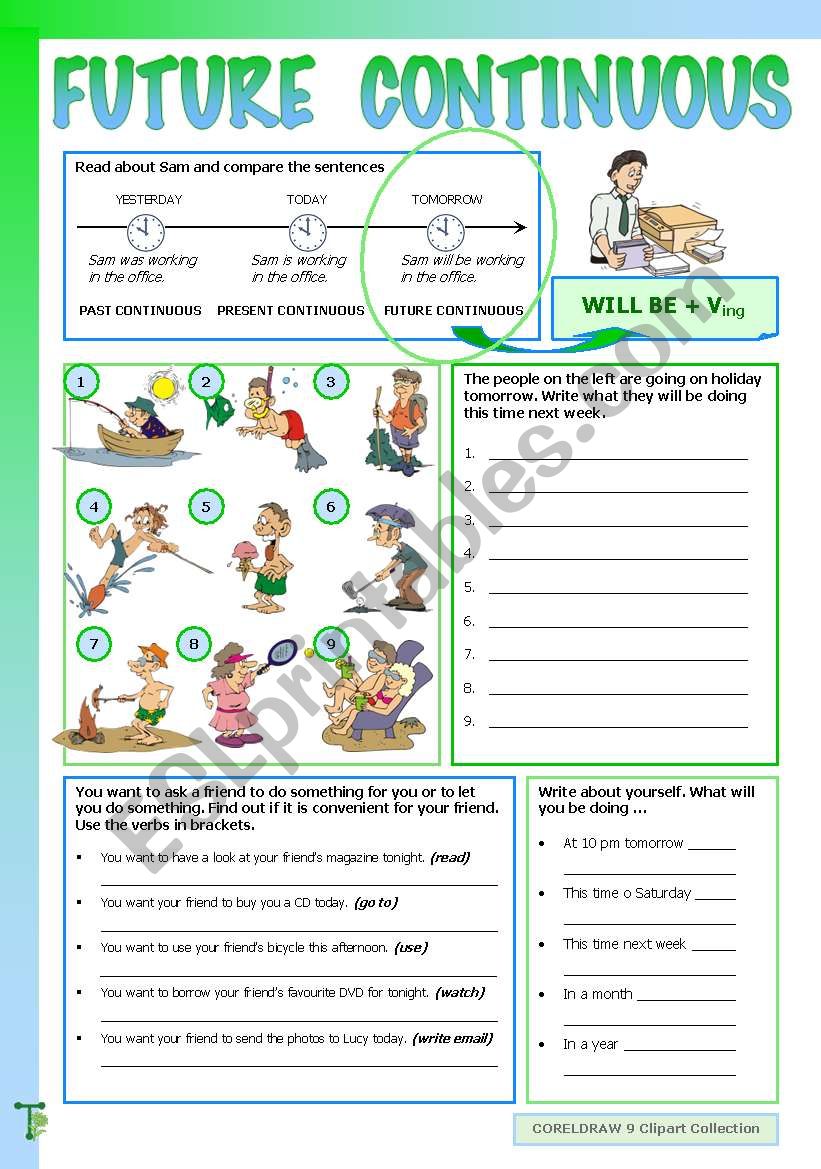
Mastering the Future Continuous: A Comprehensive Guide to Effective Worksheets
In the intricate tapestry of English grammar, tenses serve as the threads that weave together the fabric of time. Among these, the Future Continuous tense holds a unique and often underappreciated position. It allows us to describe actions that will be in progress at a specific point in the future, providing a vivid snapshot of what will be happening. While its structure (will be + verb-ing) might seem straightforward, mastering its nuances, especially differentiating it from the Simple Future or Future Perfect, often requires dedicated practice. This is where well-designed Future Continuous worksheets become indispensable tools for both educators and learners.
This article delves deep into the significance of the Future Continuous tense, explores the various types of effective Future Continuous worksheets, and provides insights into how these resources can be best utilized to achieve true mastery. By the end, you will understand why consistent engagement with targeted exercises is the cornerstone of fluency in this essential grammatical structure.
Understanding the Future Continuous Tense

Before we delve into the world of worksheets, let’s firmly grasp the essence of the Future Continuous tense.
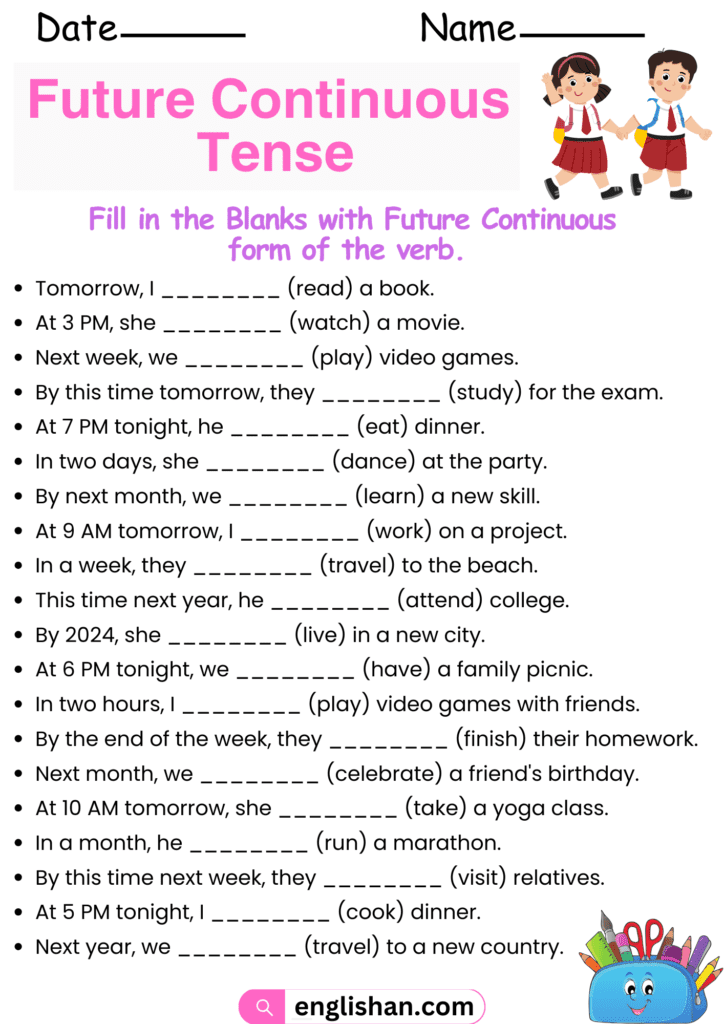
Form:

The basic structure is remarkably simple: Subject + will be + present participle (verb-ing).

- Example: I will be studying. She will be working. They will be traveling.
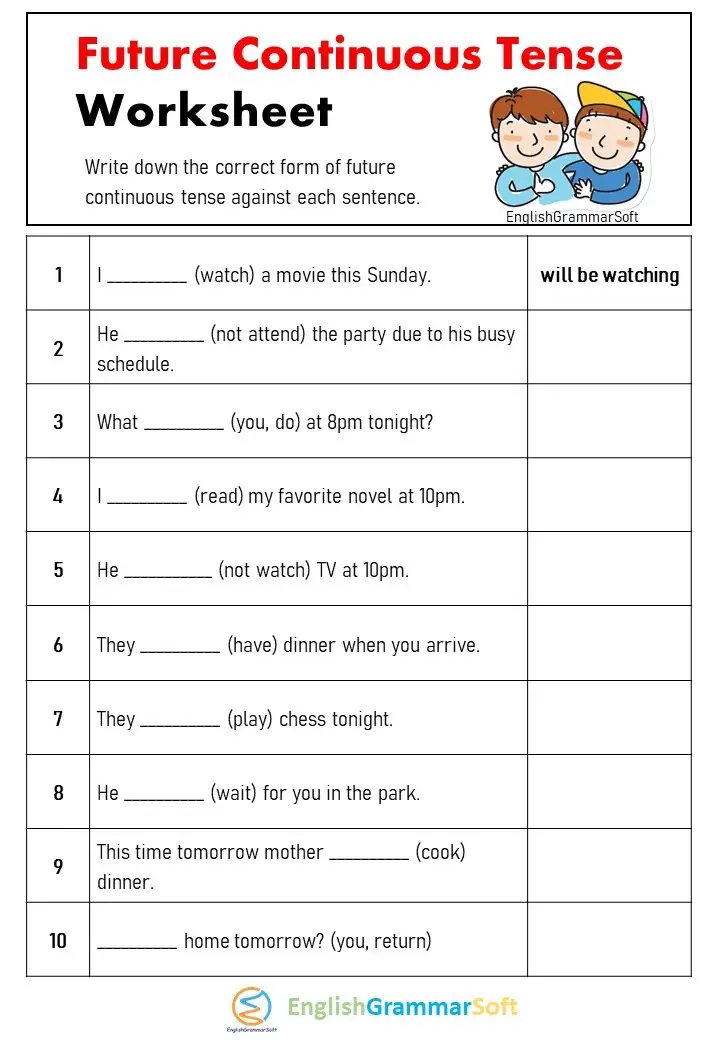
For negative forms, we insert "not" between "will" and "be": Subject + will not be (won’t be) + present participle.
- Example: I will not be studying. He won’t be sleeping.
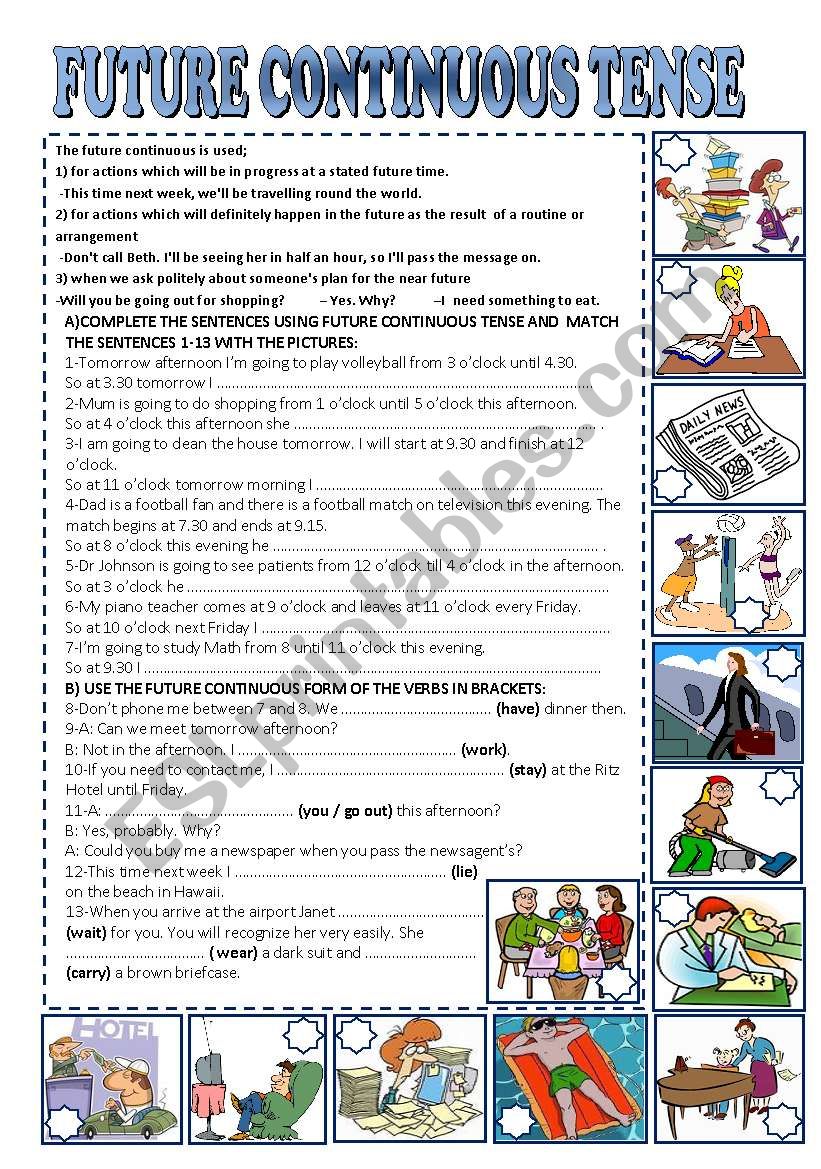
For questions, "will" moves to the beginning of the sentence: Will + Subject + be + present participle?
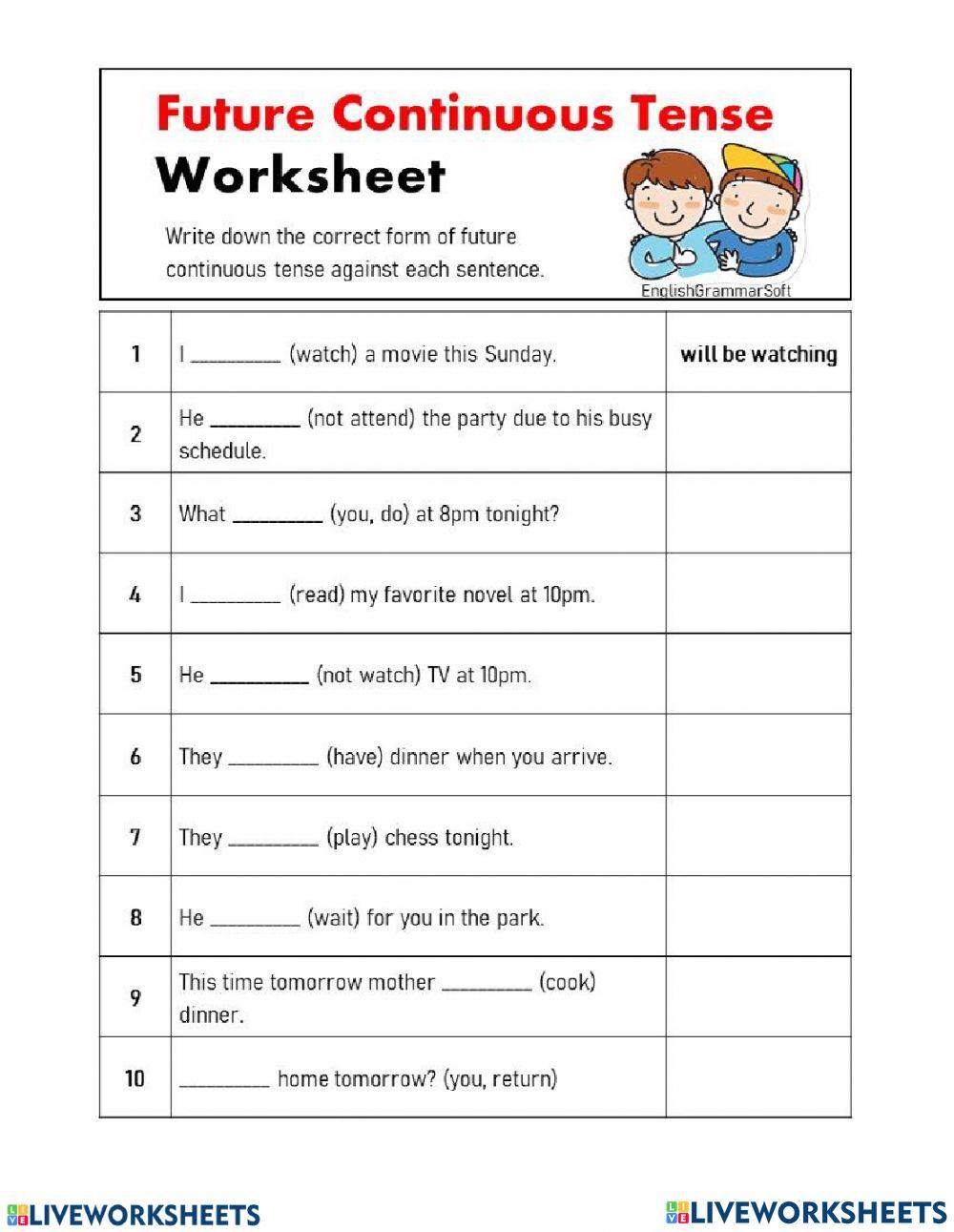
- Example: Will you be working? Will they be arriving?
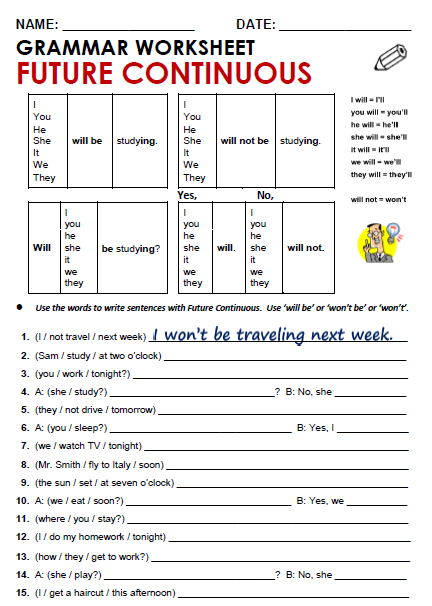
Uses:

The Future Continuous tense is primarily used for the following scenarios:
-
Actions in progress at a specific time in the future: This is its most common use. It describes an action that starts before, continues through, and possibly ends after a particular future moment.
- Example: At 8 PM tomorrow, I will be watching my favorite show. (The watching starts before 8 PM, continues at 8 PM, and likely goes on after.)
- Example: This time next week, we will be lying on a beach in Hawaii.
-
To describe interrupted actions in the future: Similar to the Past Continuous, it can show an ongoing action that gets interrupted by another shorter action.
- Example: I will be cooking dinner when you arrive. (Cooking is the longer action, arriving is the interruption.)
-
To talk about parallel actions in the future: When two or more actions will be happening simultaneously.
- Example: While she is studying, he will be playing video games. (Note: The "while" clause often uses the Present Continuous for future actions.)
-
To ask politely about someone’s plans: Often used for polite inquiries about future arrangements.
- Example: Will you be attending the conference next month?
-
To make predictions or assumptions about future events: Based on current knowledge or trends.
- Example: By 2050, many people will be living in space.
Common Time Expressions:
These phrases signal the use of the Future Continuous:
- At [specific time] tomorrow/next week/etc.
- This time next [day/week/month/year]
- In [number] hours/days/weeks
- While…
- When…
The Indispensable Role of Future Continuous Worksheets
Understanding the theory is one thing; applying it correctly and instinctively is another. This is where well-crafted Future Continuous worksheets prove their immense value. They bridge the gap between abstract grammatical rules and practical application, transforming passive learning into active engagement.
Why are worksheets so effective?
- Active Learning: Worksheets require learners to actively recall, process, and apply information, rather than just passively receiving it. This deepens understanding and retention.
- Reinforcement: Repetitive exposure to the tense in various contexts solidifies its form and usage in the learner’s mind.
- Targeted Practice: Worksheets can focus specifically on the Future Continuous, allowing learners to concentrate solely on this tense without being distracted by others.
- Assessment and Feedback: They serve as excellent tools for teachers to gauge understanding and identify areas where students might be struggling. For self-learners, answer keys provide immediate feedback.
- Self-Paced Learning: Learners can work through worksheets at their own pace, reviewing sections as needed.
- Variety of Scenarios: Good worksheets present the tense in diverse contexts, preparing learners for real-life communication.
Without dedicated practice, the Future Continuous tense can remain a theoretical concept, leading to hesitations and errors in speech and writing. Future Continuous worksheets provide the structured environment necessary for students to internalize the rules and develop fluency.
Types of Effective Future Continuous Worksheets
To cater to different learning styles and address various aspects of the Future Continuous tense, a range of worksheet types can be employed. Here are some of the most effective:
-
Fill-in-the-Blanks / Gap-Fill Exercises:
- Description: These are the most common type. Learners are given sentences with a blank space where they need to insert the correct Future Continuous form of a given verb.
- Benefit: Excellent for practicing the basic form and identifying appropriate time expressions.
- Example: Tomorrow at 7 PM, I ____ (have) dinner with my family. (Answer: will be having)
-
Sentence Transformation / Rewriting Exercises:
- Description: Students are given a sentence in another tense (e.g., Simple Future, Present Simple with future meaning) and asked to rewrite it using the Future Continuous.
- Benefit: Helps learners understand the nuances of when to use the Future Continuous versus other future tenses.
- Example: Rewrite using Future Continuous: "He will read a book all evening." (Answer: He will be reading a book all evening.)
-
Error Correction Exercises:
- Description: Sentences containing grammatical errors related to the Future Continuous are presented, and learners must identify and correct them.
- Benefit: Develops critical thinking skills and a deeper understanding of common mistakes (e.g., using "will" instead of "will be," or incorrect verb-ing forms).
- Example: Correct the sentence: "They will be go to the party tonight." (Answer: They will be going to the party tonight.)
-
Question Formation and Answering:
- Description: Learners are given statements and asked to form questions in the Future Continuous, or they are given questions and must provide appropriate short or long answers.
- Benefit: Crucial for developing conversational fluency and understanding how to both ask about and respond to ongoing future actions.
- Example: Form a question: "She will be working late." (Answer: Will she be working late?)
- Example: Answer: "Will you be studying tomorrow morning?" (Answer: Yes, I will be studying. / No, I won’t be studying.)
-
Matching Exercises:
- Description: Students match sentence halves, time expressions with appropriate Future Continuous clauses, or scenarios with relevant Future Continuous statements.
- Benefit: Good for reinforcing vocabulary related to future activities and connecting cause/effect or context.
- Example: Match: "This time next year," with "I will be living in New York."
-
Scenario-Based / Contextual Practice:
- Description: Learners are given a specific future scenario (e.g., "Imagine your day tomorrow," "What will happen at the party next Saturday?") and asked to write sentences using the Future Continuous.
- Benefit: Encourages creative application and helps learners use the tense in a more natural, communicative way. This moves beyond mere grammatical drills to more meaningful production.
- Example: Describe what you will be doing between 9 AM and 12 PM next Saturday.
-
Picture-Based Activities:
- Description: Worksheets provide images depicting future activities, and learners must describe what people or things will be doing at a certain time.
- Benefit: Appeals to visual learners and helps connect the grammar to real-world situations, enhancing comprehension and retention.
-
Dialogue Completion:
- Description: Learners complete conversations using the Future Continuous, based on the context of the dialogue.
- Benefit: Excellent for practicing the tense in a communicative setting, considering turn-taking and natural flow of conversation.
Designing and Implementing High-Quality Worksheets
Creating or selecting effective Future Continuous worksheets requires attention to several pedagogical principles:
- Clarity of Instructions: Ambiguous instructions can hinder learning. Ensure that learners clearly understand what is expected of them for each exercise.
- Varied Difficulty Levels: Start with simpler, form-focused exercises and gradually move to more complex, contextual, and communicative tasks. This scaffolding helps build confidence and deeper understanding.
- Authentic Contexts: Whenever possible, present the Future Continuous in realistic scenarios. This makes the learning more relatable and prepares learners for real-life communication. Avoid isolated, decontextualized sentences.
- Inclusion of Time Expressions: Since the Future Continuous is often tied to specific future times, worksheets should regularly incorporate common time expressions to reinforce their association with the tense.
- Answer Keys: For self-study or quick checking, clear answer keys are invaluable. They provide immediate feedback, allowing learners to correct mistakes and understand their errors.
- Integration with Other Skills: While primarily grammar-focused, good worksheets can subtly integrate reading (understanding scenarios), writing (forming sentences), and even speaking (preparing for oral practice).
- Digital vs. Printable: Consider the format. Digital interactive worksheets can offer instant feedback and multimedia elements, while printable worksheets are excellent for handwriting practice and offline use.
Tips for Teachers and Learners
For Teachers:
- Differentiate: Provide worksheets of varying difficulty to cater to different proficiency levels within your class.
- Provide Context: Always introduce the tense and its uses with clear explanations and examples before assigning worksheets.
- Encourage Discussion: After completing worksheets, discuss answers as a class. Ask students to explain why they chose a particular answer, fostering deeper analytical skills.
- Use as Diagnostic Tools: Worksheets can reveal common errors or areas of confusion, guiding your future lesson planning.
- Follow Up: Don’t let worksheet completion be the end. Integrate the Future Continuous into speaking activities, writing tasks, and listening exercises.
For Learners:
- Don’t Just Memorize: Understand when and why the Future Continuous is used, not just its form.
- Pay Attention to Time Expressions: These are your clues!
- Use a Dictionary: If you encounter unfamiliar vocabulary in a worksheet, look it up. This expands your lexicon.
- Practice Regularly: Consistency is key. Work through a variety of exercises over time.
- Try Speaking: Once you feel comfortable with the written exercises, try to form sentences in the Future Continuous about your own future plans or predictions. The ultimate goal is to use the language naturally.
Conclusion
The Future Continuous tense is a powerful tool for expressing ongoing actions in the future, adding precision and nuance to our communication. While its structure is relatively simple, its effective application requires consistent and varied practice. This is precisely where high-quality Future Continuous worksheets shine.
From basic gap-fill exercises that solidify the form to complex scenario-based tasks that encourage creative application, these worksheets are the backbone of mastering this vital grammatical structure. They provide the necessary repetition, context, and feedback for learners to move beyond rote memorization and achieve true fluency. Whether you are an educator seeking to empower your students or a self-learner striving for grammatical excellence, investing time and effort in utilizing effective Future Continuous worksheets will undoubtedly pave the way to confident and accurate English usage. Embrace the power of practice, and watch your future communication skills flourish.
